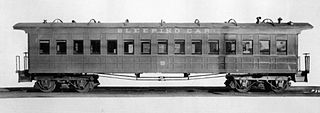
The sleeping car or sleeper is a railway passenger car that can accommodate all passengers in beds of one kind or another, for the purpose of sleeping. George Pullman was the American innovator of the sleeper car.
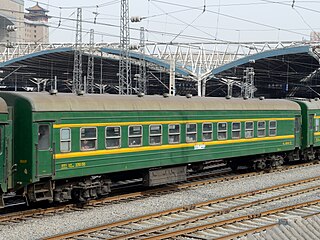
A railroad car, railcar, railway wagon, railway carriage, railway truck, railwagon, railcarriage or railtruck, also called a train car, train wagon, train carriage or train truck, is a vehicle used for the carrying of cargo or passengers on a rail transport network. Such cars, when coupled together and hauled by one or more locomotives, form a train. Alternatively, some passenger cars are self-propelled in which case they may be either single railcars or make up multiple units.

The Capitol Limited is a daily Amtrak train between Washington, D.C., and Chicago, running 764 miles (1,230 km) via Pittsburgh and Cleveland. Service began in 1981 and was named after the Baltimore and Ohio Railroad's Capitol Limited which ended in 1971 upon the formation of Amtrak. It carries the Amtrak train numbers 29 and 30, which were previously assigned to the discontinued National Limited.

The Three Rivers was an Amtrak passenger train that ran daily between New York City and Chicago via Philadelphia, Pittsburgh, and Akron. It started in 1995, replacing the Broadway Limited, and ran until March 7, 2005, when Amtrak cancelled a contract with the United States Postal Service that was specific to the train.

The Empire Builder is a daily long-distance passenger train operated by Amtrak between Chicago and either Seattle or Portland via two sections west of Spokane. Introduced in 1929, it was the flagship passenger train of the Great Northern Railway and was retained by Amtrak when it took over intercity rail service in 1971.

The Lake Shore Limited is an overnight passenger train operated by Amtrak between Chicago and the Northeastern United States, with sections to New York City and Boston. The central segment of the route runs along the southern shore of Lake Erie.

The Crescent is a daily long-distance passenger train operated by Amtrak between New York City and New Orleans. The 1,377-mile (2,216 km) route connects the Northeast to the Gulf Coast via the Appalachian Piedmont, with major stops in Charlotte, North Carolina; Atlanta, Georgia; and Birmingham, Alabama.

The Superliner is a type of bilevel intercity railroad passenger car used by Amtrak, the national rail passenger carrier in the United States. Amtrak ordered the cars to replace older single-level cars on its long-distance trains in the Western United States. The design was based on the Budd Hi-Level vehicles, employed by the Santa Fe Railway on its El Capitan trains. Pullman-Standard built 284 cars, known as Superliner I, from 1975 to 1981; Bombardier Transportation built 195, known as Superliner II, from 1991 to 1996. The Superliner I cars were the last passenger cars built by Pullman.
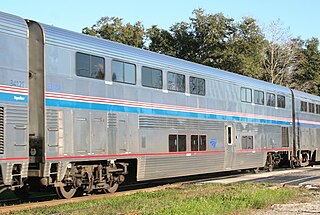
A passenger railroad car or passenger car, also called a passenger carriage, passenger coach, or passenger bogie is a railroad car that is designed to carry passengers. The term passenger car can also be associated with a sleeping car, a baggage car, a dining car, railway post office and prisoner transport cars.

Auto Train is an 855-mile (1,376 km) scheduled daily train service for passengers and their automobiles operated by Amtrak between Lorton, Virginia, and Sanford, Florida. Auto Train is the only motorail service in the United States.

The Cardinal is a long-distance passenger train operated by Amtrak between New York Penn Station and Chicago Union Station via Philadelphia, Washington, D.C., Charlottesville, Charleston, Huntington, Cincinnati, and Indianapolis. Along with the Capitol Limited and Lake Shore Limited, it is one of three trains linking the Northeast and Chicago. Its 1,146-mile (1,844 km) trip between New York and Chicago takes 281⁄4 hours.

Amtrak has used a variety of paint schemes (liveries) on its rolling stock since taking over intercity passenger rail service in the United States in 1971. A series of seven schemes termed Phases, first introduced in 1972, have seen the widest use. Phases primarily use geometric arrangements of red, white, and blue—the national colors of the United States—part of Amtrak's patriotic visual identity.

Amfleet is a fleet of single-level intercity railroad passenger cars built by the Budd Company for American company Amtrak in the late 1970s and early 1980s. Budd based the Amfleet design on its earlier Metroliner electric multiple unit. An initial order for 57 cars in 1973 to supplement the Metroliners on the Northeast Corridor grew to two orders totaling 642 cars, sufficient to reequip all the services on the Northeast Corridor and many other routes around the United States. The first 492 cars, known as Amfleet I and completed between 1975 and 1977, were designed for short-distance service. A second order of 150 cars, known as Amfleet II and completed between 1980 and 1983, were designed for long-distance service. They were the last intercity passenger cars built by Budd.
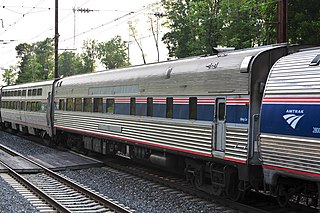
Amtrak's Heritage Fleet consisted of the rolling stock provided to it when it assumed passenger service on commercial railroads. The name was applied to a 1977–1983 program that converted the older, mainly streamlined, cars from steam heating to head-end power. The final Heritage Fleet car was retired in 2019.

The Viewliner is a single-level railroad car type operated by Amtrak on most long-distance routes operating east of Chicago. The first production cars, consisting of an order of 50 sleeping cars, entered service in 1994. From 2015-2016, 70 Viewliner II baggage cars entered service. The new baggage cars are used on all Amtrak trains with full baggage cars, both single-level and bi-level, and replaced all of the Heritage Fleet baggage cars that Amtrak inherited from the freight railroads when it was established in 1971. From 2016-2019, 25 Viewliner II dining cars entered service, which replaced all of the Heritage Fleet dining cars. In 2019, 10 Viewliner II baggage-dormitory cars entered service. The last cars to enter service were 25 Viewliner II sleeping cars in 2021.
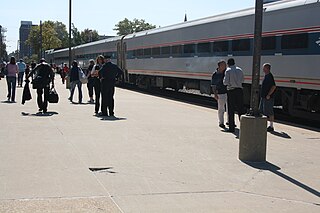
The Horizon is a type of single-level intercity railroad passenger car used by Amtrak, the national rail passenger carrier in the United States. Amtrak ordered the cars to supplement their existing fleet of Amfleet I single-level cars used on shorter distance corridor trains. The design was based on the Comet railcar used for commuter railroads, but with modifications to make them more suitable for intercity service. Bombardier Transportation built 104 cars from 1988 to 1990 in two basic types: coaches and food service (café) cars.

The California Car is the first generation of intercity railcars owned by the California Department of Transportation (Caltrans) and operated by Amtrak under the Amtrak California brand on intercity corridor routes in Northern and Central California. The cars were built in the mid-1990s for the Caltrans Division of Rail by Morrison–Knudsen and the American Passenger Rail Car Company (Amerail). The cars are similar in exterior dimensions to Amtrak's Superliner, but original in design to provide rolling stock suitable for California intercity services up to six hours, with more frequent stops than most other Amtrak routes. All cars were overhauled by Alstom at its Mare Island facility between 2009 and 2012.

The Surfliner is a family of bi-level intercity railcars derived from the California Car. Like its predecessor, it is derived from the Superliner in design, and operated on Amtrak California's intercity routes in California. They are owned by both Amtrak and California Department of Transportation (Caltrans).
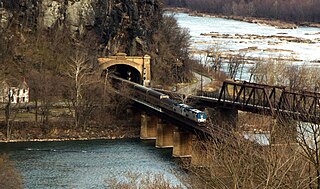
The Long Distance Service Line is the division of Amtrak responsible for operating all intercity passenger train services in the United States longer than 750 miles (1,210 km). There are fifteen such routes as of 2023, serving over 300 stations in 39 states.



















